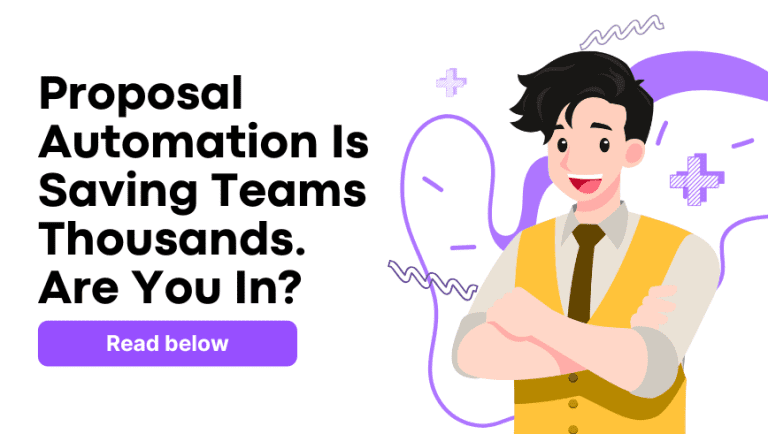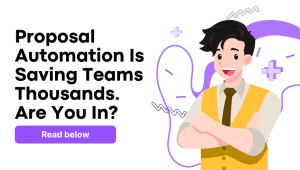Es gibt unzählige Artikel, die Ihnen erklären, wie Sie eine RFP-Antwort richtig formulieren. Aber wissen Sie, was praktisch garantiert zum Scheitern verurteilt ist? Sich einmischen, ohne die richtigen Fragen zu stellen.

Wer zu früh mit dem Schreiben beginnt, riskiert, wichtige Details zu übersehen oder, schlimmer noch, das falsche Problem zu lösen. So verschwenden Teams Zeit und verschicken Vorschläge, die nicht ankommen. Die erfolgreichsten Antworten beginnen immer mit einer Pause und ein paar klugen Schachzügen. Und das beginnt damit, die richtigen Fragen zu stellen.
Dieser Leitfaden behandelt die wichtigsten Fragen, die Sie vor der Beantwortung einer Ausschreibung stellen sollten. Wir haben sie in vier einfache Abschnitte unterteilt, damit Sie verstehen, was der Kunde wirklich möchte, wie Sie Ihre Lösung positionieren und Ihr Team optimal aufeinander abstimmen, bevor das erste Wort geschrieben ist. Ziel ist es, Ihre Antwort prägnant, relevant und leicht zu beantworten zu gestalten und dabei die Best Practices für Ausschreibungen zu befolgen.
Über das Projekt
Beginnen wir mit den Grundlagen des RFP-Antwortprozesses. Wenn Sie nicht verstehen, was der Kunde tatsächlich versucht, raten Sie nur. Fragen Sie sich also:
1. Welches eigentliche Problem versucht der Kunde zu lösen?
Dies sollte Ihre Antwort maßgeblich beeinflussen. Wenn Sie das eigentliche Problem nicht lösen, spielen Funktionen und Preise keine Rolle.
2. Welche Ziele hoffen Sie mit diesem Projekt zu erreichen?
Wenn Sie ihre Ziele verstehen, können Sie Ihre Lösung als Gewinn für sie darstellen.
3. Wie sind Zeitplan und Umfang des Projekts?
So erfahren Sie, wie groß das Projekt ist und wie schnell Ergebnisse erwartet werden. Dies hilft Ihnen bei der Planung der Teamkapazität und der Preisgestaltung.
4. Was sind die erwarteten Ergebnisse?
Sie müssen absolut klar formulieren, was Sie liefern sollen. So gibt es später keine Überraschungen.
5. Gibt es ein festgelegtes Budget oder zumindest einen Rahmen?
Wenn kein Budget vorhanden ist, seien Sie vorsichtig. Wenn ja, können Sie es für die Gestaltung Ihrer Lösung nutzen.
6. Gibt es vorhandene Systeme, Tools oder Prozesse, in die Ihre Lösung integriert werden muss?
Dies kann erhebliche Auswirkungen auf Komplexität, Zeitplan und Kosten haben – fragen Sie also frühzeitig.
7. Wie wird der Kunde den Erfolg messen?
Wenn Sie ihre KPIs kennen, können Sie Ihre Ergebnisse auf das ausrichten, was ihnen wirklich wichtig ist.
Über Ihr Unternehmen
In diesem Teil geht es darum, sicherzustellen, Du passen gut. Passt die Ausschreibung zum Fachwissen und den Fähigkeiten Ihres Unternehmens? Selbst wenn Sie dürfen antworten – sollten Sie?
8. Entsprechen Ihre Dienste oder Lösungen tatsächlich ihren Anforderungen?
Klingt offensichtlich, aber Sie wären überrascht, wie oft Unternehmen den falschen RFPs hinterherjagen.
9. Verfügen Sie über einschlägige Erfahrung in dieser Branche oder bei diesem Projekttyp?
Sie möchten wissen, dass Sie dies bereits getan haben – und zwar gut. Um dies zu vermeiden, sollten Sie die bewährten RFP-Methoden befolgen und Ihr Angebot im Rahmen des RFP-Antwortprozesses an den Bedürfnissen des Kunden ausrichten.
10. Können Sie dies mit Fallstudien oder Beispielen belegen?
Echte Ergebnisse schaffen Vertrauen. Wenn Sie Beweise haben, teilen Sie sie. Wenn nicht, überlegen Sie, ob dies das richtige Projekt für Sie ist.
11. Wer gehört zum Team, das sich darum kümmern würde, und was sind die Stärken dieser Personen?
Kunden möchten wissen, wer hinter den Kulissen steckt, und nicht nur Ihren Markennamen.
12. Wie berechnen Sie die Preise für Ihre Projekte und wie würde die Preisgestaltung hier aussehen?
Stellen Sie sicher, dass Ihr Preismodell zu den Kaufplänen der Kunden passt.
13. Was ist Ihr Liefer- oder Implementierungsansatz?
Ihre Methodik sagt viel über Ihre Arbeitsweise aus. Seien Sie sich über Ihre Prozesse und Zeitpläne im Klaren.
14. Wie gehen Sie mit Support, Risiken und Unbekanntem um?
Kein Projekt läuft perfekt. Wenn Sie zeigen, dass Sie über Risiken und die Unterstützung nach dem Start nachgedacht haben, kann Ihnen das einen Vorteil verschaffen.
Informationen zum RFP-Prozess
Ein gut geschriebener Vorschlag kann dennoch sein Ziel verfehlen, wenn Sie nicht verstehen Wie Entscheidungen werden getroffen.
15. Nach welchen Kriterien wählt der Kunde einen Anbieter aus?
Manche legen den Schwerpunkt auf die Kosten. Anderen sind Erfahrung oder Geschwindigkeit wichtiger. Wissen Sie, wo Sie glänzen können.
16. Wie werden die einzelnen Teile des Vorschlags gewichtet?
Wenn die technischen Möglichkeiten 60% der Punktzahl ausmachen und der Preis 10% beträgt, ändert sich Ihre Strategie völlig.
17. Was ist der genaue Einreichungstermin (und das Format)?
Zu spät ist zu spät – auch wenn es nur fünf Minuten sind. Informieren Sie sich über die Frist und etwaige besondere Abgabeanforderungen.
18. Gibt es Must-haves, die Anbieter disqualifizieren?
Stellen Sie sicher, dass Sie alle Mindestanforderungen erfüllen, bevor Sie Zeit investieren.
19. Wer sind die Entscheidungsträger, die dies überprüfen?
Wenn Sie Ihr Publikum kennen, können Sie im richtigen Ton und mit der richtigen Detailliertheit schreiben.
20. Wird es Folgeveranstaltungen geben, etwa eine Pitch-Präsentation oder eine Frage-und-Antwort-Runde?
Wenn ja, sollten Sie sich frühzeitig vorbereiten und dies bei Ihrer Ressourcenplanung berücksichtigen.
Andere Dinge, die Sie wissen sollten, bevor Sie Ja sagen
Dies ist der Kontext. Das Gesamtbild. Es hilft Ihnen, zwischen den Zeilen zu lesen und herauszufinden Warum diese RFP überhaupt existiert.
21. Warum wird die RFP jetzt herausgegeben?
Wird ein neuer Lieferant ersetzt? Wird etwas Neues eingeführt? Gibt es einen Führungswechsel? Wenn Sie den Zeitpunkt kennen, können Sie sich besser positionieren.
22. Welche Schwachstellen versuchen sie zu lösen?
Wenn Sie in Ihrem Vorschlag direkt darauf eingehen können, haben Sie bereits ein stärkeres Argument vorgebracht.
23. Wer sind die wahrscheinlichen Konkurrenten, die hier ein Angebot abgeben?
Wenn Sie wissen, wer sonst noch antworten könnte, können Sie Ihre Unterscheidungsmerkmale herausarbeiten.
24. Wie können Sie sich von allen anderen abheben?
Was ist Ihre einzigartige Stärke? Was bieten Sie, das schwer zu kopieren ist? Nutzen Sie es.
25. Welche Risiken sind mit dem Projekt verbunden – und wie würden Sie damit umgehen?
Risiken zu erwähnen, zeugt von Reife. Einen Plan zu haben, um diese Risiken zu bewältigen, zeugt von Führungsstärke.
26. Gibt es rechtliche, regulatorische oder Compliance-Faktoren, die Sie berücksichtigen müssen?
Das Fehlen einer Klausel kann den gesamten Deal gefährden. Fragen Sie lieber frühzeitig nach und bauen Sie darauf auf.
Unsere Meinung zur RFP-Antwort
Was sollten Sie also tun, wenn Sie auf eine RFP antworten?

Unser Rat: Betrachten Sie Ausschreibungen nicht als bloße Abhakprojekte. Hinter jeder Ausschreibungsformel verbirgt sich ein Geschäftsziel, ein Problempunkt und ein Entscheidungsteam, das Klarheit statt Komplexität sucht. Je besser Sie die Welt der Ausschreibung verstehen und wissen, wozu Sie passen, desto höher sind Ihre Erfolgschancen.
Die meisten Anbieter überstürzen ihre Arbeit. Sie reagieren auf jede Ausschreibung, ohne lange nachzudenken. Wenn Sie jedoch innehalten, fundiertere Fragen stellen und die Chance gezielt einschätzen, sparen Sie Zeit, reduzieren Nacharbeit und erhöhen Ihre Erfolgsquote.
Nutzen Sie diesen Fragenkatalog als Bauchgefühl-Check, bevor Sie sich festlegen. Es geht weniger darum, alle Antworten zu kennen, sondern vielmehr darum, zu wissen, welche wichtig sind.
RFPs für alle Stakeholder
Dieser Leitfaden wurde aus der Sicht eines Anbieters erstellt, aber lassen Sie uns kurz einen Schritt weiter gehen.

Wenn Sie eine RFP schreiben: Fragen Sie sich: „Geben Sie den Anbietern die richtigen Informationen für ihre Arbeit?“ Klare Ziele, Kontext, Zeitpläne und Bewertungskriterien tragen wesentlich dazu bei, bessere Antworten zu erhalten.
Wenn Sie den RFP-Prozess intern starten: Stellen Sie Fragen wie: „Brauchen wir wirklich eine RFP?“, „Was ist unser Ziel?“, „Wer wird die Antworten auswerten?“, „Sind wir bereit, einen Anbieter an Bord zu holen?“
Wenn Sie auf eine RFP antworten: Nutzen Sie jede Frage in diesem Leitfaden, um die Gelegenheit einzuschätzen, Ihre Geschichte zu gestalten und frühzeitig auf etwaige Warnsignale hinzuweisen.
Der RFP-Beantwortungsprozess sollte für niemanden ein Ratespiel sein. Wenn beide Seiten nachdenklich sind, sind die Ergebnisse besser. Punkt.
Personalisierte Beantwortung einer RFP mit Proposal.Biz
Um Ausschreibungen erfolgreich zu gestalten, kommt es nicht nur auf schnelles Schreiben oder ansprechende Gestaltung an. Es geht um Klarheit, Passgenauigkeit und Strategie. Um überzeugendere Angebote einzureichen, sollten Sie im Rahmen Ihres Ausschreibungsprozesses zunächst intelligentere Fragen stellen.
Und wenn Sie es satt haben, diesen gesamten Prozess in Tabellenkalkulationen und Ordnern zu verwalten, haben wir gute Neuigkeiten: Wir bauen Vorschlag Biz: ein Angebotsmanagement-Tool für Teams die intelligenter arbeiten, schneller reagieren und mehr abschließen möchten.
Möchten Sie frühzeitigen Zugriff? Tragen Sie sich in unsere Insider-Warteliste ein. Lassen Sie es uns gemeinsam richtig machen. Für uns zählt bei erfolgreichen Ausschreibungen Klarheit. Passgenauigkeit. Strategie. Für überzeugendere Angebote stellen Sie zunächst intelligentere Fragen.
Wenn Sie das nächste Mal eine Ausschreibung erhalten, antworten Sie nicht überstürzt. Halten Sie inne, stellen Sie diese Fragen und erstellen Sie ein Angebot, das sowohl für den Anbieter als auch für Sie sinnvoll ist.




